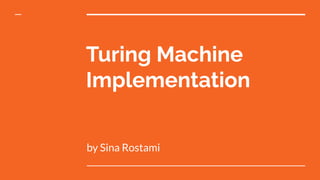
Turing machine implementation
- 1. Turing Machine Implementation by Sina Rostami
- 2. 1. Turing Machine Re-introduction to the Turing Machine. 2. Implementation concepts Basis for Implementing the TM. 3. Implementation Implementing the TM in C++ programming lang.
- 3. Turing Machine Tip We use _ (underscore) to show TM's blank symbol in this lecture. δ : Q × Γ → Q × Γ × {L, R} Members of δ AKA Rules. The heart of a Turing machine is its transition function δ, as it tells us how the machine gets from one configuration to another. A Turing machine configuration is described by its current state, the current tape contents, and the current head location.
- 4. TM Configuration example For a state q and two strings u and v, over the tape alphabet Γ, we write uqv : for the configuration where the current state is q, the current tape contents is uv, and the current head location is the first symbol of v.
- 5. Turing Machine Configuration For example 1011 q7 0111 represents the configuration when the tape is 10110111, the current state is q7, and the head is currently on the first 0 after q7.
- 6. Turing Machine Configuration An accepting configuration is a configuration in which the state is the accept state. A rejecting configuration is a configuration in which the state is the reject state. Accepting and rejecting configurations are halting configurations.
- 7. Turing Machine example For L = {01*0} q_0 q_1 q_2 q_aq_r 0 -> 0, R 0 -> 0, R _ -> _, R 1 -> 1, R _ -> _, R 0 -> 0, R 1 -> 1, R 1 -> 1, R _ -> _, R
- 8. Implementation Basis We need following concepts to implement TM. ➔ TM ‘s 7-Tuple For implementing we need the 7-tuple which we discussed earlier. ➔ I/O We need some input and output feature to give the initializing fields like 7-tuple and input string, and also see the result of the TM.
- 9. But How to Implement our 7-Tuple in code !!!???
- 10. Abstraction!
- 11. Let’s Start We start from abstracting some basis, and then go for some coding and test our idea.
- 12. Concepts ➔ Direction Left, Right ➔ Rule a -> b, R ➔ State q_0, q_1, .., q_a, q_r ➔ Result ongoing, accepted, rejected ➔ TM!
- 13. Direction Only can have 2 values, LEFT and RIGHT So we Use a simple enum to abstract the direction. enum class Direction { LEFT, RIGHT, };
- 14. Rule a -> b , R In a single rule we must have 2 characters: ● The character that TM reads from tape ● The character that TM writes in tape And also a Direction, which we already defined. struct Rule { char read_symbol, write_symbol; Direction direction; };
- 15. State Every state has a name ( like q_0, q_1, …, q_a, q_r) and also some transitions to other states with specified Rule! So we need rules that’ve been mapped to states. struct State { string name; map<Rule, State> transitions; };
- 16. Result Like the Direction, Result also can have only 3 values: 1. ON_GOING 2. ACCEPTED 3. REJECTED enum class Result { ACCEPTED, REJECTED, ON_GOING, };
- 17. TM Turing should have followings: Some states and also q_0, q_a, q_r Some chars as input alphabet Some chars as tape alphabet struct TuringMachine { vector<State> states; State q_0, q_a, q_r; vector<char> input_alphabet; vector<char> tape_alphabet; }; Tip We use std::vector as container
- 18. Milestone Turing’s work Our work TM intro. Implementation basis Abstract concepts Implement required and auxiliary functions. Run and test codes Turing’s work is much greater than our’s!
- 19. What is left ? Test our TM with some examples. And try to break it Write auxiliary functions for connecting structures together and checking given string to the TM parse the TM inputs. In other word handle to make an instance of our TM.
- 20. Check input string func. Result check_input_string(string input_string) { size_t current_index = 0; State current_state = q_0; Result result = Result::ON_GOING; print_current_config(input_string, current_index, current_state); while (result == Result::ON_GOING) { handle_current_char(input_string, current_index, current_state); print_current_config(input_string, current_index, current_state); if (current_state == q_a) result = Result::ACCEPTED; else if (current_state == q_r) result = Result::REJECTED; } return result; }
- 21. Handle current char func. void handle_current_char(string &input_string, size_t ¤t_index, State ¤t_state) { char &head_symbol = input_string[current_index]; for (auto &pair : current_state.transitions) { if (pair.first.read_symbol == head_symbol) { head_symbol = pair.first.write_symbol; // a -> b current_index = (pair.first.direction == Direction::LEFT) // R, L ? current_index - 1 : current_index + 1; current_state = pair.second; return; } } }
- 22. We’re Almost Done! Now let’s parse and test the example we just checked out in TM intro.
- 23. Parsing and testing an example func. Rule r1('0', '0', Direction::RIGHT); Rule r2('1', '1', Direction::RIGHT); Rule r3('_', '_', Direction::RIGHT); Parse Rules
- 24. Parsing and testing an example func. State q_0("q_0"); State q_1("q_1"); State q_2("q_2"); State q_a("q_a"); State q_r("q_r"); Parse States
- 25. Parsing and testing an example func. q_0.transitions.emplace(r1, q_1); q_0.transitions.emplace(r2, q_r); q_0.transitions.emplace(r3, q_r); q_1.transitions.emplace(r2, q_1); q_1.transitions.emplace(r1, q_2); q_1.transitions.emplace(r3, q_r); q_2.transitions.emplace(r3, q_a); q_2.transitions.emplace(r1, q_r); q_2.transitions.emplace(r2, q_r); Parse Transitions(connect States to each other)
- 26. Parsing and testing an example func. TuringMachine tm({q_0, q_1, q_2, q_a, q_r}, {'0', '1'}, {'0', '1', '_'}, q_0, q_a, q_r); Result result = tm.check_input_string("0111110___"); switch (result) { case Result::ACCEPTED: cout << "ACCEPTED" << endl; break; case Result::REJECTED: cout << "REJECTED" << endl; break; } Create a TM, Call the chek func. on a string and see the output
- 28. The result on wrong input! "01111101___"
- 29. Thanks! I hope this gave you a newer and deeper perspective to the TM. You can findthis presentation and the source files inmygithubprofilewith linkbellow: https://github.com/sina-rostami Course : Theory of Languages and Automata Instructor : Dr. Khasteh Fall 2020
